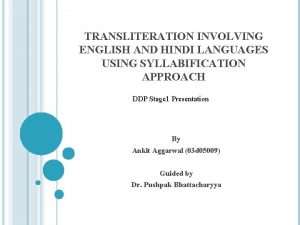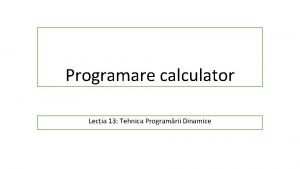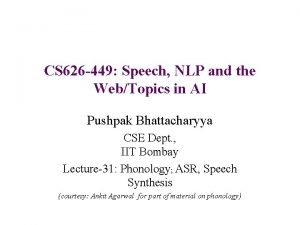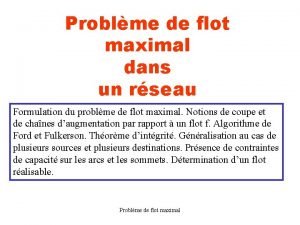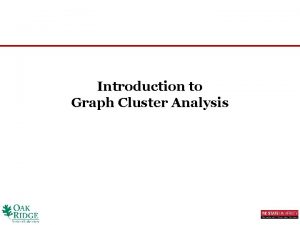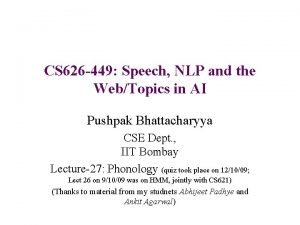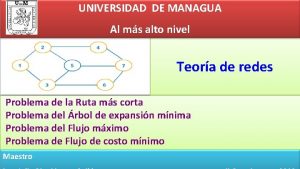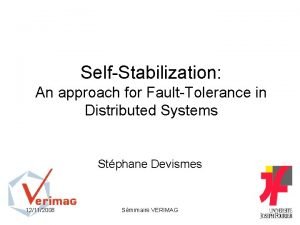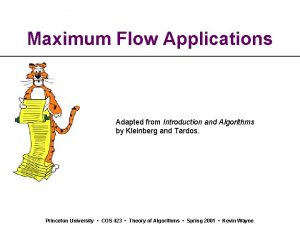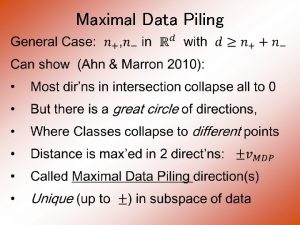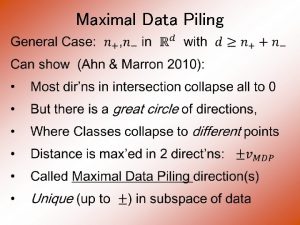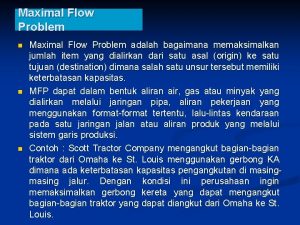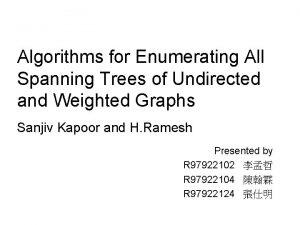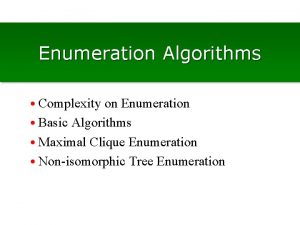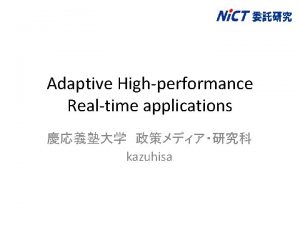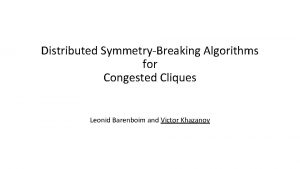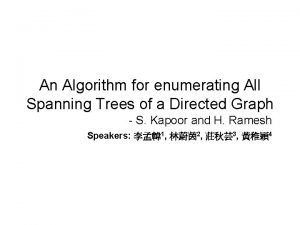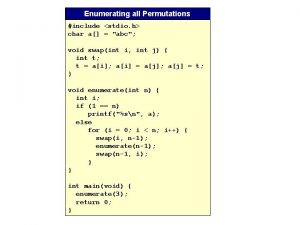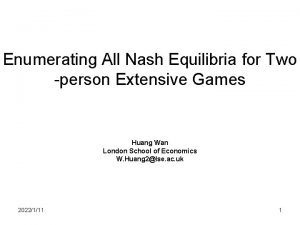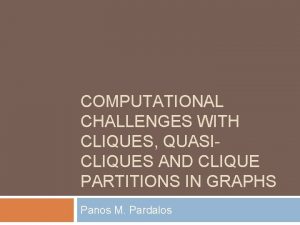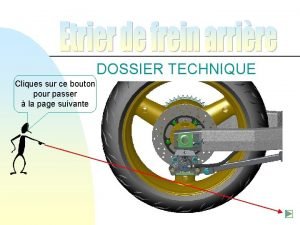New Algorithms for Enumerating All Maximal Cliques Kazuhisa








![Child of Maximal Clique Γ(vi) : vertices adjacent to vi K[i] = C ( Child of Maximal Clique Γ(vi) : vertices adjacent to vi K[i] = C (](https://slidetodoc.com/presentation_image_h2/a1c53d2f89ca46c55933c238d8ffb492/image-9.jpg)
![Characterization of Child The parent of K[i] = K ⇔ (1) no vj , Characterization of Child The parent of K[i] = K ⇔ (1) no vj ,](https://slidetodoc.com/presentation_image_h2/a1c53d2f89ca46c55933c238d8ffb492/image-10.jpg)

![Sparse Cases ・ If vi is adjacent to no vertex in K K[i] = Sparse Cases ・ If vi is adjacent to no vertex in K K[i] =](https://slidetodoc.com/presentation_image_h2/a1c53d2f89ca46c55933c238d8ffb492/image-12.jpg)

![Fast Construction of K[i] ・ For any maximal bipartite clique K K ∩V 2 Fast Construction of K[i] ・ For any maximal bipartite clique K K ∩V 2](https://slidetodoc.com/presentation_image_h2/a1c53d2f89ca46c55933c238d8ffb492/image-14.jpg)








- Slides: 22

New Algorithms for Enumerating All Maximal Cliques Kazuhisa Makino Osaka University JAPAN Takeaki Uno National Institute of Informatics, JAPAN 9/Jul/2004 SWAT 2004

Background Recently, Enumeration algorithms are interesting ・ There are still many unsolved nice problems (unlike to ordinal discrete algorithms) ・ Recent increase of computer power makes many enumeration problems practically solvable many applications have been appearing, such as, genome, data mining, clustering, so on ・ Some (theoretical) algorithms use enumeration as subroutines (recognition of perfect graph)

Background (cont. ) ・ My institute has 100 researchers of informatics ・ At least 5 researchers (independently) use implementations of enumeration algorithms ・ Suppose that there are 100, 000 researchers of informatics in the world 5000 researchers use enumeration algorithms ? ? ?

Problems and Results Problem 1 : for a given graph G=(V, E), enumerate all maximal cliques in G Problem 2 : for a given bipartite graph G=(V 1∪V 2, E), enumerate all maximal bipartite cliques in G ( Problem 2 is a special case of Problem 1 ) ・ We propose algorithms for solving these problems, reduce the time complexity in dense cases and sparse cases. ・ Computational experiments for random graphs and real-world data

Difficulty ・ Consider branch-and-bound type enumeration: divide maximal cliques into two groups maximal cliques including v / not including v ・ If a group includes no maximal clique, cut off the branch Finding a maximal clique not including given vertices of S is NP-Complete Can not cut off subproblems(branches) including no maximal clique v 1∈K v 2∈K v 1∈K

Existing Studies and Ours O(|V||E|): Tsukiyama, Ide, Ariyoshi & Shirakawa, O(|V||E|), lexicographic order: Johnson, Yanakakis & Papadimitriou O(a(G)|E|): Chiba & Nishizeki ( a(G): arboricity of G with m/(n-1) ≦ a(G) ≦m 1/2 ) ・ many heuristic algorithms in data mining, for bipartite case Ours: O(|V|2. 376) (dense case) O(Δ 4) (sparse case) O((Δ*)4 + θ 3 ) (θ ( vertices have degree > Δ* ) O(Δ 3) (bipartite case) O(Δ 2) (bipartite case with using much memory)

Enumeration of Maximal Cliques ・ Improved version of algorithm of Tsukiyama et. al. Idea: Construct a route on all maximal cliques to be traversed ・ For a maximal clique K of G = ( V, E ) : C (K) : lexicographically maximum maximal clique including K K≦i : vertices of K with indices ≦ i i(K) : minimum index s. t. C(K≦i) = C(K≦i+1) parent of a maximal clique K : C(K≦i(K)-1) ・ parent is lexicographically larger than K 9 4 1 11 7 3 2 K 10 5 6 8 i(K) Lexicographically larger 1, 2, 3 > 1, 2, 4 1, 3, 6 > 1, 4, 5

Graph Representation of Relation ・ Parent-child relation is acyclic graph representation forms a tree (enumeration tree) tree Visit all maximal cliques by depth-first search ・ need to find children of a maximal clique
![Child of Maximal Clique Γvi vertices adjacent to vi Ki C Child of Maximal Clique Γ(vi) : vertices adjacent to vi K[i] = C (](https://slidetodoc.com/presentation_image_h2/a1c53d2f89ca46c55933c238d8ffb492/image-9.jpg)
Child of Maximal Clique Γ(vi) : vertices adjacent to vi K[i] = C ( K≦i ∩ Γ(vi) ∪ {vi} ) ・ H is a child of K only if H = K[i] for some i>i(K) (H is a child of K if the parent of K[i] is K ) ・ i(K[i]) = i K, i(K)=6 9 4 1 11 7 3 10 2 5 6 8 K[8] ・construct K[i] in O(|E|) time ・construct parent in O(|E|) time ( O(Δ 2 ) time) ・for i=i(K)+1, …, |V| in O(|V||E|) time enumerate O(|V||E|) time per maximal clique
![Characterization of Child The parent of Ki K 1 no vj Characterization of Child The parent of K[i] = K ⇔ (1) no vj ,](https://slidetodoc.com/presentation_image_h2/a1c53d2f89ca46c55933c238d8ffb492/image-10.jpg)
Characterization of Child The parent of K[i] = K ⇔ (1) no vj , j<i is adjacent to all vertices in K≦i ∩Γ(vi) ∪ {vi} (2) no vj , j<i is adjacent to all vertices in K≦i∩Γ(vi) ∪ K≦j (1) is not satisfied ⇔ K[i] and parent of K[i] includes vj∈K (2) is not satisfied ⇔ parent of K[i] includes vj∈K 5 7 1 4 3 9 10 K = {3, 4, 7, 9} K[10] = {3, 7, 10} K≦ 5 = {3, 4} K ≦ 7∩Γ(v 10) = {3, 7} K≦ 5∪ K ≦ 10∩Γ(v 10) ∪ {v 10}

Use of Matrix Multiplication ・ Check the conditions (1) and (2) by matrix multiplication (1) no vj , j<i is adjacent to all vertices in K ≦i ∩Γ(vi) ∪ {vi} ith row of left ⇒ K≦i∩Γ(vi)∪{vi} = |K≦i∩Γ(vi)∪{vi}| ? jth column of right ⇒ Γ(vj) ij cell of product ⇒ | K≦i∩Γ(vi)∪{vi} ∩ Γ(vj) | Γ(vj) ∩ K ≦i ∩Γ(vi) ∪ {vi} K≦i∩Γ(vi)∪{vi} Γ(vj) Condition (2) can be checked in the same way Checked in O( |V|2. 368 ) time ⇒ time complexity is O( |V|2. 368 ) for each
![Sparse Cases If vi is adjacent to no vertex in K Ki Sparse Cases ・ If vi is adjacent to no vertex in K K[i] =](https://slidetodoc.com/presentation_image_h2/a1c53d2f89ca46c55933c238d8ffb492/image-12.jpg)
Sparse Cases ・ If vi is adjacent to no vertex in K K[i] = C ( K≦i ∩ Γ(vi) ∪ {vi} ) = C ({vi}) parent of K[i] = C ({vi}) ≦i ) If C ({vi}) ≦i =φ, parent of K[i] is K 0 If C ({vi}) ≦i ≠φ, (1) is not satisfied If K ≠ K 0, K[i] is not a child of K Δ: max. degree ・ Since |K|≦Δ+1 , at most Δ(Δ+1) vertices are adjacent to K ・ Each K[i] takes O(Δ 2) time to construct the parent O(Δ 4 ) per maximal clique O((Δ*)4 + |Θ|3 ) if partially dense Δ*: max. degree in V\Θ

Bipartite Clique ・ Enumerate maximal bipartite cliques in G =(V 1 ∪V 2 , E ) ( = maximal cliques in G’ = (V 1 ∪V 2 , E ∪V 1 ×V 1 ∪V 2×V 2 )) enumerated in O( |V|2. 368 ) time for each ・ But a sparse bipartite graph will be dense need some improvements for sparse cases V 1 V 2
![Fast Construction of Ki For any maximal bipartite clique K K V 2 Fast Construction of K[i] ・ For any maximal bipartite clique K K ∩V 2](https://slidetodoc.com/presentation_image_h2/a1c53d2f89ca46c55933c238d8ffb492/image-14.jpg)
Fast Construction of K[i] ・ For any maximal bipartite clique K K ∩V 2 = ∩v∈K ∩V 1 Γ(v) K ∩V 1 = ∩v∈K ∩V 2 Γ(v) K[v 1] ・ K[i]∩V 1 for all i are computed in O(Δ 2) time ・ K[i] for all i are computed in O(Δ 3) time v 1 v 2 v 5 v 6 K[i] V 1 V 2 1 2 3 K[v 6] Γ(1) 4 vi Γ(2) Γ(3) Γ(4)

Checking the Parent ・ Put small indices to V 1 , large indices to V 2 V 1 1 2 3 V 2 |V 1|+1 |V 1|+2 |V 1|-1 |V 1| ・・・ K[i] is a child of K ⇔ K[i]≦i = K≦i checked in O(Δ) time K[i] V 1 V 2 Enumerated in O(Δ 3) time for each vi O(Δ 2) by using memory

Computational Experiments ・ for graphs randomly generated ・ vertex vi is connected to vertices from i-r to i+r with probability 1/2 ・ Faster than Tsukiyama’s algorithm ・ Computation time is linear in maximum degree

Benchmark Problems ・ Problem of finding frequent closed item sets from database equivalent to maximal bipartite clique enumeration ・ Used on KDDcup (data mining algorithm competition ) BMS-Web. View 1 (from Web-log data) |V|= 60, 000, ave. degree 2. 5 BMS-Web. View 2 (from Web-log data) |V|= 80, 000, ave. degree 5 BMS-POS (from POS data) |V|= 510, 000, ave. degree 6 IBM-Artificial (artificial data) |V|= 100, 000 , ave. degree 10

Results

Conclusion and Future Work ・ Proposed fast algorithms for enumerating maximal cliques: O(|V|2. 376), O(Δ 4 ), O((Δ*)4 + θ 3 ) maximal bipartite cliques: O(|V|2. 376), O(Δ 3 ), O(Δ 2) ・ Examined benchmark problems of data mining, and showed that our algorithm performs well. Future work: ・ Can we improve more? What is the difficulty ? ・ Can we enumerate other maximal (minimal) graph objects ? ・ Can we apply matrix multiplication to other enumeration problems ? ・ What can be enumerated efficiently in practice ?

Frequent Sets Input graph: An item and a customer is connected iff the customer purchased the item customer 1 beer customer 2 nappy customer 3 milk customer 4 In a maximal bipartite clique: Customers: have similar favorites Items: frequently purchased together [Agrawal et al. 96, Zaki et al. 02, Pei 00, Han 00, … ]

Few Large Degree Vertices ・ Very few vertices (denoted by Θ) have large degrees small degree < Δ’ ・ Divide the maximal cliques into two groups: (a) cliques not included in Θ (b) cliques included in Θ ・ (a) can be enumerated in O(Δ’ 4) time ・ Maximal clique K in the induced graph by Θ is a maximal clique of G ⇔ K is not included in any of (a) O(|Θ|3) time for each O(Δ’ 4 + |Θ|3 ) per maximal clique large degree

Avoid Duplications by Using Memory ・We can avoid duplications by storing all maximal bipartite cliques ・ From K ∩V 1 =Γ(K ∩V 2) , we store all K ∩V 1 1. Get a K from memory (which is un-operated) 2. generate all K[i]∩V 1 3. Store each K[i]∩V 1 if it is not in memory 4. Go to 1 if a maximal clique is un-operated Enumerated in O(Δ 2) time for each
 What is the difference between cliques and crowds
What is the difference between cliques and crowds Tu cliques
Tu cliques The chief determinant of popularity in high school is:
The chief determinant of popularity in high school is: Name all rays
Name all rays Maximal onset principle
Maximal onset principle Point of maximal impulse
Point of maximal impulse Izzi njemački 5 razred
Izzi njemački 5 razred Point of maximal impulse
Point of maximal impulse Fundamental teaching techniques of lsvt big
Fundamental teaching techniques of lsvt big Programare calculator
Programare calculator Zscore
Zscore Maximal onset principle example
Maximal onset principle example Maximal and closed frequent itemsets
Maximal and closed frequent itemsets Coupe minimale
Coupe minimale Maximal clique
Maximal clique Webtopings
Webtopings Maximal heart rate
Maximal heart rate Heart rate clicker
Heart rate clicker Ruta mas corta
Ruta mas corta Maximal independent set
Maximal independent set Maximal flow
Maximal flow Airline scheduling max flow
Airline scheduling max flow Fspos vägledning för kontinuitetshantering
Fspos vägledning för kontinuitetshantering




